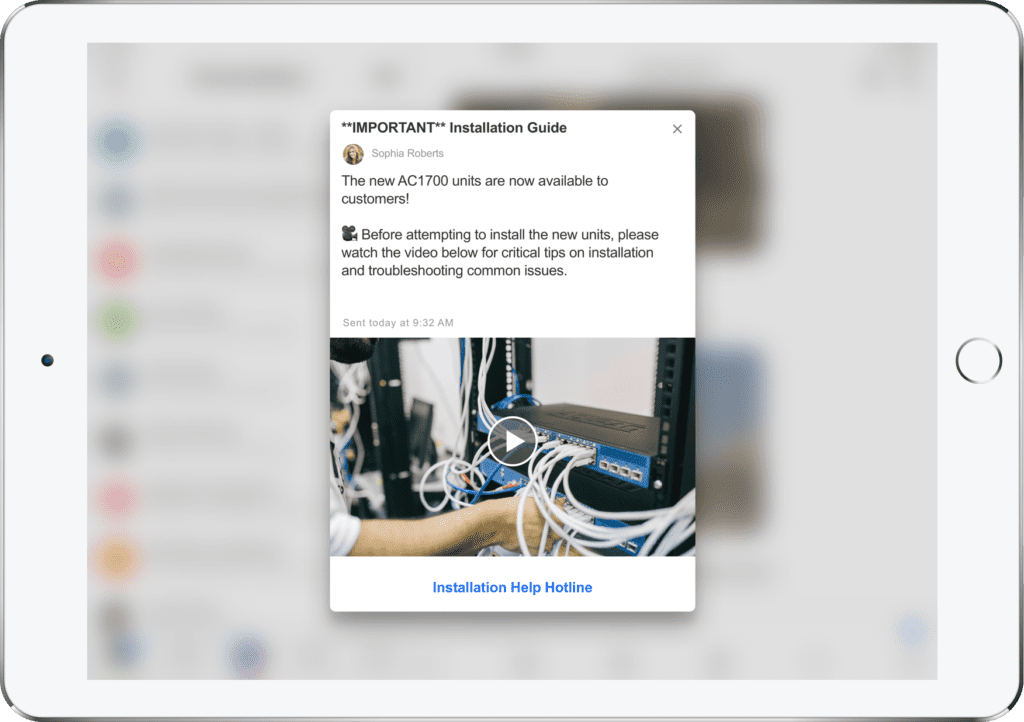Editor’s note: The following post from Kristen Wells originally appeared on Zinc’s blog and is used here with permission. Today, ServiceMax announced its acquisition of Zinc. To learn more about the acquisition and how it will help service leaders to extend real-time communication to employees in the field, join the upcoming webinar with Stacey Epstein (CEO, Zinc), Jim Thomas (principal solutions architect, Zinc), and Lubor Ptacek (VP of product marketing, ServiceMax.)
Tactics For Resolving Frontline Communication Problems
Effective frontline employee communication is critical for businesses large and small. When it comes to managing, and communicating with, frontline employees, it can get a little tricky. Frontline teams aren’t sitting in front of computers and checking email. They are on-the-go to the next job site or working directly with a customer or servicing equipment 30 feet in the air, and so on.
Reaching these customer-facing employees, who make up 80 percent of the workforce, is critical for business success and requires a different, mobile-first approach. These do’s and don’ts for improving frontline employee communication will help you create a more engaged and productive workforce, and help to mitigate employee communication problems.
1. DO: Connect Frontline Workers With the Greater Organization
Frontline or deskless workers are often siloed from the rest of their organization. Connecting these employees with each other as well as those back at the office is incredibly fruitful for both employee engagement and performance.
Many deskless workers, such as field service technicians, don’t get much face time with their teammates. Group messaging conversations where teams share stories, chat about their favorite shows or organize weekend BBQs help cultivate a culture of connectivity that drives engagement.
In addition, most deskless teams have to rely on traditional forms of communication like email and call centers to reach office-based support teams when they need help. This clunky process wastes valuable times and frustrates employees. Adopting mobile-friendly, real-time frontline communication solutions will remove frustration from your employees’ workday and better equip them to solve problems in real-time.
2. DO: Leverage Mobile-First Communication Apps
When a segment of your workforce is deskless, providing intuitive, mobile-friendly solutions are critical. The problem is, most enterprise solutions provide poor mobile experiences and thus don’t get adopted by mobile workers. This has led to the use of consumer messaging apps like WhatsApp in the workplace. And while they are well-liked and easy to use, these apps don’t provide the administrative controls and data privacy that enterprises need.
This is the challenge that Zinc’s Real-Time Communication Platform has been solving for deskless workers across industries. With all modes (messaging, voice, video, content sharing, and broadcasts) on an intuitive platform that anyone can pick up and know how to use, companies are improving key business metrics as well as empowering their deskless workers like never before.
3. DO: Recognize Exceptional Work
Sometimes we forget to take time out of the day to applaud team members that go above and beyond. These mini celebrations not only matter to the employee but fellow team members love to see others do well and get recognition. A team or region-wide group message is a great place to celebrate Rockstar employees.
4. DON’T: Rely on Email
When you need to share urgent or important information, email is not the way to go. Most frontline employees don’t even have a corporate email address and if they do, it’s rarely checked. On top of this, there is no way to know when and if employees have received the message.
To avoid the employee communication problems that can come with using email, you can reach employees directly on their mobile devices with Broadcast alerts. Broadcasts are eye-catching push notifications that alert employees to critical information. After sending a Broadcast, you can then see who has read and interacted with the message.

Image: Zinc
5. DON’T: Forget to Solicit Feedback from Frontline Workers
Employee feedback is a powerful tool for improving business processes. Frontline teams who interact with customers on a daily basis often have some of the best ideas. Empowering them to share their insights and offer suggestions is a win-win.
To effectively get feedback from deskless workers, offer multiple options such as multiple choice surveys, open-ended surveys, and in-person meetings and always follow up thanking employees for their participation.
6. DON’T: Overload Deskless Teams With Irrelevant Info
Over-communication of important, relevant information is necessary for ensuring your message is heard loud and clear. But if you overload employees with numerous messages that don’t apply to them or are devoid of any context, they will start tuning everything out.
Make an effort to only send information to the applicable teams and tailor the message so it’s meaningful to them. For example, safety procedures that apply to one set of employees, such as those working in a warehouse, don’t need to be shared with everyone in the organization. Same for job-site hazards that only affect a certain department or region.
These do’s and don’ts in managing frontline employee communication will ensure your frontline workers aren’t siloed from the information, people and resources they need to succeed on the job. When deskless teams know they have the support of the entire organization behind them, they are unstoppable.
Read more about the acquisition and join the upcoming webinar (Thurs., March 14).


Share this: